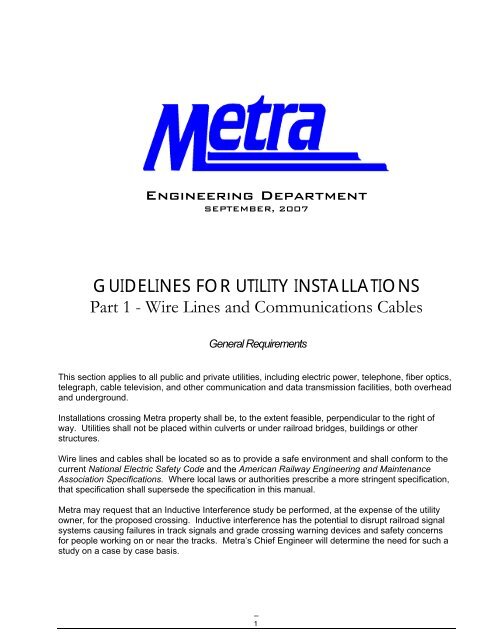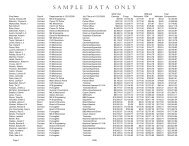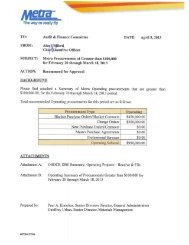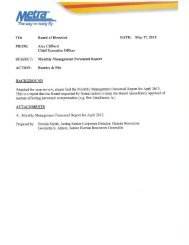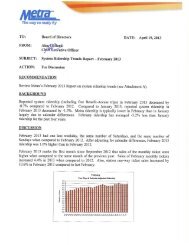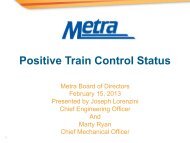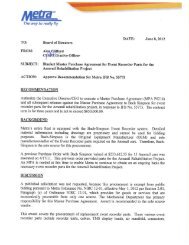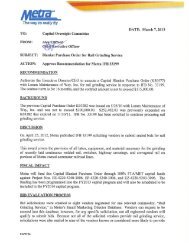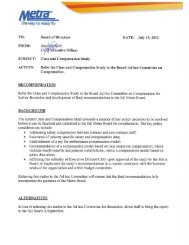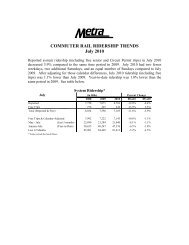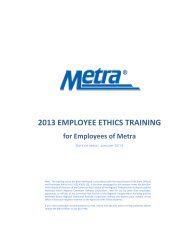GUIDELINES FOR UTILITY INSTALLATIONS Part 1 - Wire ... - Metra
GUIDELINES FOR UTILITY INSTALLATIONS Part 1 - Wire ... - Metra
GUIDELINES FOR UTILITY INSTALLATIONS Part 1 - Wire ... - Metra
You also want an ePaper? Increase the reach of your titles
YUMPU automatically turns print PDFs into web optimized ePapers that Google loves.
Engineering Department<br />
SEPTEMBER, 2007<br />
<strong>GUIDELINES</strong> <strong>FOR</strong> <strong>UTILITY</strong> <strong>INSTALLATIONS</strong><br />
<strong>Part</strong> 1 - <strong>Wire</strong> Lines and Communications Cables<br />
General Requirements<br />
This section applies to all public and private utilities, including electric power, telephone, fiber optics,<br />
telegraph, cable television, and other communication and data transmission facilities, both overhead<br />
and underground.<br />
Installations crossing <strong>Metra</strong> property shall be, to the extent feasible, perpendicular to the right of<br />
way. Utilities shall not be placed within culverts or under railroad bridges, buildings or other<br />
structures.<br />
<strong>Wire</strong> lines and cables shall be located so as to provide a safe environment and shall conform to the<br />
current National Electric Safety Code and the American Railway Engineering and Maintenance<br />
Association Specifications. Where local laws or authorities prescribe a more stringent specification,<br />
that specification shall supersede the specification in this manual.<br />
<strong>Metra</strong> may request that an Inductive Interference study be performed, at the expense of the utility<br />
owner, for the proposed crossing. Inductive interference has the potential to disrupt railroad signal<br />
systems causing failures in track signals and grade crossing warning devices and safety concerns<br />
for people working on or near the tracks. <strong>Metra</strong>’s Chief Engineer will determine the need for such a<br />
study on a case by case basis.<br />
1
All wire line applications shall include a plan and cross section view, at a clear and legible scale, of<br />
the proposed installation. Plan views shall include the following:<br />
• Date of plan, scale and north arrow<br />
• Centerline of all railroad tracks<br />
• Distance (in feet) to nearest railroad milepost or grade crossing (centerline of<br />
road)<br />
• Right of way dimensions<br />
• Angle of crossing relative to right of way<br />
• Location of all railroad signal facilities and pole lines<br />
• Location of all existing utility pole lines and above ground utilities<br />
• Location of all existing underground utility markers<br />
• Location of proposed poles and distance from centerline of nearest track to edge<br />
of pole<br />
• Length of wire line span across tracks from pole to pole<br />
Cross section views shall include the following:<br />
• Date of plan, scale<br />
• All railroad tracks<br />
• Right of way dimensions<br />
• Vertical clearance from bottom of sag to top of rail on all tracks<br />
• Location of poles and distance from centerline of nearest track to edge of pole<br />
• Length of span across tracks from pole to pole<br />
• Location of all existing railroad pole lines and utility lines<br />
• Location of all grade crossing signal equipment (gates, flashers, masts,<br />
cantilevers, etc.) if located near or within a road crossing
Specifications for Overhead <strong>Wire</strong> Line Crossings<br />
1. These specifications shall apply to overhead electric power line crossings over railroad rights of<br />
way, tracks, and signal and communication wires.<br />
2. The Crossing Company shall submit plans showing proposed construction for review and<br />
approval with its application. A signed easement agreement, formal approval of plans, and<br />
subsequent contractor right of entry (see right of entry application) is required prior to<br />
commencement of construction.<br />
3. The poles or towers supporting the line shall preferably be outside <strong>Metra</strong>’s right of way<br />
4. The poles or towers shall preferably be in a straight line.<br />
5. Crossing poles and towers shall be located as far as possible from combustible structures. The<br />
space around the poles and towers shall be kept free from underbrush, grass, and other<br />
combustible material.<br />
6. The side clearance from the pole or tower from the nearest rail may not be less than 12 feet l, with<br />
a minimum distance of 8.5 feet from the nearest rail to any cross arm, guy, or other attachment.<br />
Unguyed poles must be located a minimum distance equal to the height of the pole above the<br />
ground line plus 10 feet from the centerline of the nearest track.<br />
7. Where necessary for unobstructed view of wayside signals, signs, etc., <strong>Metra</strong> may require greater<br />
clearances than specified above.<br />
8. Wooden poles supporting the crossing span shall be side-guyed in both directions, if practicable,<br />
and be head-guyed away from the crossing span. Braces may be used instead of guys. All<br />
down guys shall have high visibility guarding.<br />
9. The poles or towers shall be plainly marked with the name, initials, or trademark and the pole<br />
numbers, if used, of the Crossing Company. When required by <strong>Metra</strong>, the Crossing Company<br />
shall place, on all crossing structures located on <strong>Metra</strong> property, warning signs of approved<br />
design.<br />
10. In general, lines shall be arranged in the order of their operating voltages, conductors of the<br />
greatest voltage occupying the highest position. Where lines of lower voltage are permitted to<br />
cross over circuits of higher voltage, their mechanical strength shall conform to that required for<br />
the higher voltage lines.<br />
11. Where the wires or cables of the crossing span are supported on both crossing supports by pin<br />
type insulators, or by suspension type insulators in a suspended position or in a strain position, the<br />
vertical clearance between the wires or cables of the crossing span and the top of rail, at 60˚<br />
Fahrenheit and no wind, shall not be less than the following:<br />
a. Where the distance from the nearer crossing support to the point where the line crosses<br />
the farthest rail is 75 feet or less, the minimum clearance above the top of rail shall be:<br />
- 3 -
i. 28 feet for lines carrying 0 – 15,000 volts<br />
ii. 30 feet for lines carrying 15,000 – 50,000 volts<br />
iii. Lines over 50,000 volts – 30 feet plus 0.4 inches for each 1,000 volts above<br />
50,000.<br />
b. Where the distance from the nearer crossing support to the point where the line crosses<br />
over the farthest rail is more than 75 feet, the clearance of (a) above shall be increased by<br />
0.2 feet for each 10 feet in excess of 75 feet in length.<br />
c. For the protection of railroad crane and pile driver operations, and the protection of the<br />
wire line crossing, it is preferred that any wire or cable crossing be located at least 1,000<br />
feet from any railroad bridge, trestle or large culvert. When it is necessary to locate less<br />
than 1,000 feet from such a structure, the vertical clearance shall not be less than 50 feet.<br />
12. The clearance between any two wires crossing each other and carried on different supports shall<br />
be not less than the following:<br />
a. Where the upper conductor or wire has fixed supports, the sum of the distances from the<br />
point of intersection of the two crossing wires to the nearer supporting structure of each<br />
span does not exceed 100 feet:<br />
NATURE OF WIRES<br />
CROSSED OVER<br />
Communication<br />
Supply cables having<br />
permanently grounded<br />
metal sheath – all<br />
voltage<br />
Line<br />
<strong>Wire</strong>s<br />
Note: for voltage exceeding 50,000, the clearances given above shall be increased at the rate of 0.4 inches<br />
for each 1,000 volts in excess of 50,000.<br />
b. Where the upper conductor or wire has fixed supports, and the sum of the distances from<br />
the point of intersection of the two crossing wires to the nearer supporting structure of<br />
- 4 -<br />
Service<br />
Drops<br />
Open supply wires:<br />
0 – 8,700<br />
volts<br />
8,700 –<br />
50,000 volts<br />
Guys, Messengers,<br />
span wires,<br />
lightning protection<br />
wires, service drops<br />
0 - 750 volts<br />
Feet Feet Feet Feet Feet Feet<br />
Communication<br />
Supply cables having<br />
2 4 2 4 6 2<br />
permanently grounded metal<br />
sheath – all voltage<br />
Open supply wires:<br />
4 2 2 4 4 2<br />
0 - 750 volts 4 2 2 2 4 2<br />
750 – 8,700 volts 4 2 4 2 4 4<br />
8,700 – 50,000 volts<br />
Guys, Messengers, span<br />
6 4 6 4 4 6<br />
wires, lightning protection<br />
wires, service drops 0 -<br />
2 2 2 4 4 2<br />
750 volts
each span exceeds 100 feet, the clearances listed in the above table shall be increased<br />
by 0.10 feet for each 10 feet in excess of the 100 feet.<br />
c. Conductors supported by suspension type insulators at crossings over communication<br />
wires shall be increased by such an amount that the values specified in the above table<br />
will be maintained in the event of a broken conductor in either adjacent span, provided<br />
such conductor is supported as follows:<br />
• At one support by suspension type insulators in a suspended position, and at the<br />
other support by insulators not free to swing (including semi-strain type<br />
insulator).<br />
• At one support by a strain insulator, and at the other support by a semi-strain<br />
type insulator.<br />
13. Splices shall not be made in the crossing span, and preferably not in the adjacent spans, which<br />
are depended upon for withstanding the longitudinal tension of the crossing conductors. Taps<br />
shall not be made in the crossing span. If a splice or tap is made in any conductor in the span<br />
adjacent to the crossing span, it shall, where practicable, be placed at a point nearer to the<br />
crossover support than is the nearest conductor crossed over.<br />
14. Cradles, baskets, and overhead bridges are generally not acceptable and shall not be used<br />
except under unusual conditions where it is economical to build such a structure of sufficiently<br />
substantial nature and when approved by <strong>Metra</strong>. Drop outs shall not be used.<br />
15. The crossing construction shall be subject at all times to the inspection and approval of <strong>Metra</strong>.<br />
16. All parts of the supporting structures of the crossing span shall be inspected annually by the<br />
owner and all defective parts shall be promptly restored to a safe condition.<br />
17. The details of construction and maintenance of the crossing, unless otherwise specified herein,<br />
shall be in accordance with the current specifications of the National Electrical Safety Code,<br />
except when modified construction is permitted by <strong>Metra</strong>.<br />
- 5 -
Specifications for Overhead Communication Line Crossings<br />
1. These specifications shall apply to the construction of overhead communication lines crossing or<br />
paralleling the right of way. <strong>Wire</strong>s covered by these specifications shall not carry more than 400<br />
volts.<br />
2. Spans crossing the right of way shall preferably have the supporting poles located outside the<br />
right of way. The crossing span, where practicable, shall not exceed 175 feet. Where practicable,<br />
the adjacent spans shall not exceed the length of the crossing span by more than 50%. Where<br />
practicable, the poles supporting the crossing span and the adjacent spans shall be in a straight<br />
line.<br />
3. Pole lines paralleling the right of way shall have the poles located not less than 12 feet from the<br />
nearest rail, with a minimum distance of 8.5 feet from the nearest rail to any cross arm, guy, or<br />
other attachment. When necessary to provide safe operating conditions which require<br />
unobscured view along the track for signal, signs, etc., <strong>Metra</strong> may require clearances greater than<br />
those specified above.<br />
4. Wood poles shall be new and structurally sound. If guys are omitted, poles shall be located<br />
a minimum distance from the centerline of any track equal to the height of the pole above the<br />
ground line plus 10 feet. Gains shall not be cut to a depth of more than one-half inch.<br />
Spliced poles shall not be used in the crossing span.<br />
The following table specifies the minimum depth of setting for un-guyed poles in average soil and in<br />
rock.<br />
MINIMUM DEPTH OF SETTING <strong>FOR</strong> UN-GUYED POLES<br />
Depth in feet in average soil for different classes of poles<br />
Length of Pole (feet) Class 4 Class 5 and 6 Class 7 Depth in Feet in Rock for<br />
all Classes<br />
16 4.00 3.75 3.00<br />
18 4.25 4.00 3.25<br />
20 4.25 4.25 4.00 3.25<br />
22 4.75 4.50 4.25 3.50<br />
25 5.25 4.75 4.50 3.75<br />
27 5.50 5.00 4.75 4.00<br />
30 5.75 5.25 5.00 4.25<br />
35 6.00 5.50 5.25 4.50<br />
40 6.25 5.75 5.50 4.75<br />
45 6.50 6.00 5.75 5.00<br />
50 6.75 6.25 6.00 5.25<br />
55 7.00 6.50 5.50<br />
60 7.25 6.75 5.75<br />
- 6 -
9. Conductors shall be of material, or combination of materials, which will not corrode excessively<br />
under the prevailing conditions. The minimum allowable sizes of conductors in a span crossing<br />
over a railroad which does not, in the same span, cross over supply conductors exceeding 750<br />
volts shall be as listed in the following table. Conductors of material other than those specified in<br />
the table below shall be of such size and so erected as to have mechanical strength not less than<br />
the sizes of the copper conductors specified.<br />
10. Poles supporting the crossing span shall be guyed in both directions, if practicable, and shall be<br />
head guyed away from the crossing span when the crossing span places undue stress on the<br />
crossing poles. Guys shall be of galvanized steel or stainless steel and shall have high visibility<br />
guarding.<br />
11. Suspension strands shall be of galvanized steel or other material that will not corrode excessively<br />
under the prevailing conditions.<br />
12. The construction shall be subject to the inspection of <strong>Metra</strong> and shall comply with the<br />
requirements of these specifications. Defective material shall be rejected and replaced with<br />
acceptable material.<br />
13. The crossing shall be maintained in a safe condition. The poles, crossarms, guys, wires, and<br />
other parts and materials used in the structure of the crossing shall be periodically inspected, and<br />
all defects shall be promptly repaired by the owner of the line. The guys and anchors shall be<br />
maintained so that the guys are kept taut and serve the purpose fro which they are intended. The<br />
line wires shall be kept to the proper sag. Underbrush, grass, or other combustible material shall<br />
be kept removed, by the crossing owner, from the poles for a sufficient distance to reduce fire<br />
hazard to a minimum.<br />
- 8 -
14. The following table lists minimum required vertical clearances:<br />
<strong>Wire</strong> Line Clearance Chart<br />
VOLTAGE (to ground) MINIMUM CLEARANCE<br />
REQUIRED ABOVE TOP<br />
OF RAIL<br />
Insulated Communication <strong>Wire</strong>lines 23.5 ft.<br />
Non-insulated Communication <strong>Wire</strong>lines 24 ft.<br />
Shielded or insulated power wirelines 0-750 volts 24 ft.<br />
Shielded or insulated power wirelines (Lashed to bare ground<br />
messenger)<br />
751V to 22kV<br />
Open supply conductors<br />
0-750 volts<br />
Open supply conductors<br />
751V – 22kV<br />
- 9 -<br />
24.5 ft.<br />
24.5 ft.<br />
26.5 ft.<br />
50kV 27.5 ft.<br />
100kV 29.2 ft.<br />
150kV 30.8 ft.<br />
200kV 32.5 ft.
Specifications for Underground Electric Power Lines<br />
1. <strong>Wire</strong> lines located within the right of way must be located as far as possible from existing<br />
tracks and other railroad facilities and as close to the right of way line as possible due to the<br />
fact that <strong>Metra</strong> occupies the right of way for the purpose of operating a commuter railroad.<br />
All installations shall be designed and constructed so the railroad operations and facilities are<br />
not interfered with. Additionally, the proposed installation shall be located to minimize<br />
encumbrance to the right of way in order that <strong>Metra</strong> will have unrestricted use of the property<br />
for current and future operations.<br />
2. <strong>Wire</strong> lines shall be located to cross tracks at approximately right angles where conditions<br />
permit.<br />
3. A <strong>Metra</strong> signal department employee must locate any buried signal cables prior to<br />
construction.<br />
4. The tops of ducts and cable systems structures of underground cable crossings shall be<br />
located at a depth of not less than 5 feet - 6 inches below base of rail and not less than 36<br />
inches below bottoms of ditches or 48 inches below natural ground, with the lowest depth<br />
governing. Deeper installations may be required to avoid underground railroad facilities.<br />
5. Underground crossings of power supply cables with maximum voltage of 750 volts and<br />
communication cables of low voltage may be installed by pushing a galvanized steel pipe<br />
under the tracks at a depth specified above to serve as a conduit, provided such pipe<br />
extends the full width of the right of way. All ducts and/or encasements beneath the tracks<br />
must be capable of withstanding E-80 loading and conform to AREMA Specifications. Any<br />
conduits and/or encasements larger than four inches will be governed entirely by those<br />
specifications which normally cover pipelines (see “Specifications for Pipelines). Jacking or<br />
boring installation is preferred, and no water is to be used in the installation of the<br />
encasement. Plastic casing pipe is not permitted.<br />
6. Underground crossings of power supply cables operating above 750 volts will be installed at<br />
depths specified above and in addition, between the points where the underground crossing<br />
enters and leaves METRA property, the cable is to be enclosed in galvanized steel pipe or<br />
approved concrete encased duct for mechanical protection of the cable. No unprotected<br />
cable of this potential will be permitted.<br />
7. All underground installations must be located a minimum of 50 feet from the end of any<br />
railroad bridge, centerline of any culvert or switch area to the centerline of the wire line<br />
crossing.<br />
8. If the proposed location of the wire line crosses existing culverts, the top of the buried wire<br />
line must be installed a minimum of 5' below the culvert invert. If the location crosses a ditch<br />
beyond the end of the culvert (field side) then the top of the buried encroachment must be<br />
installed 5' below the bottom elevation of the ditch.<br />
- 10 -
9. Manholes must be capable of withstanding H-20 highway loading requirements and must be<br />
installed so as not to create a stumbling hazard.<br />
10. All underground installations carrying power or communication wires and cables shall be<br />
constructed and properly marked with signs.<br />
11. In addition to the requirements of these specifications, the underground crossing is to<br />
conform to the requirements of the National Electrical Safety Code, current edition. The<br />
crossing is also to conform to the requirements of any local or state laws or regulations of<br />
any local code enforcing authority that may be in effect at the time of the installation.<br />
- 11 -


